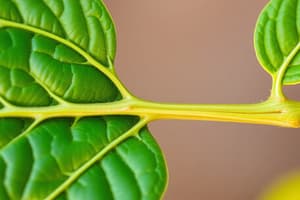Podcast
Questions and Answers
Which structure is absent in a monocot stem?
Which structure is absent in a monocot stem?
- Cambium (correct)
- Pith
- Xylem
- Phloem
What is the arrangement of xylem and phloem in a dicot root?
What is the arrangement of xylem and phloem in a dicot root?
- In a ring
- Star-shaped (correct)
- Alternately in a line
- Scattered randomly
Which of the following is true about monocot roots compared to monocot stems?
Which of the following is true about monocot roots compared to monocot stems?
- Roots have vascular bundles scattered
- Both lack pericycle
- Roots have root hairs but stems do not (correct)
- Both have pith
What is the primary function of the stem in a plant?
What is the primary function of the stem in a plant?
Which part of the plant lacks a pith?
Which part of the plant lacks a pith?
Which feature differentiates dicot roots from dicot stems?
Which feature differentiates dicot roots from dicot stems?
How are the vascular bundles arranged in a monocot root?
How are the vascular bundles arranged in a monocot root?
What type of cells primarily make up the pith in dicot stems?
What type of cells primarily make up the pith in dicot stems?
What is the primary function of a transport system in multicellular organisms?
What is the primary function of a transport system in multicellular organisms?
Which structure primarily transports water and minerals in higher plants?
Which structure primarily transports water and minerals in higher plants?
Which part of the root protects the root tip as it pushes through soil?
Which part of the root protects the root tip as it pushes through soil?
What is the main role of root hairs in plants?
What is the main role of root hairs in plants?
What type of cells comprise the cortex of the root?
What type of cells comprise the cortex of the root?
Which structure regulates the entry of water and mineral salts into the vascular bundle of the root?
Which structure regulates the entry of water and mineral salts into the vascular bundle of the root?
What provides energy for the active uptake of mineral salts in root hairs?
What provides energy for the active uptake of mineral salts in root hairs?
What is the function of the pericycle in roots?
What is the function of the pericycle in roots?
Which statement about diffusion in unicellular organisms is true?
Which statement about diffusion in unicellular organisms is true?
What characterizes the endodermis in the root?
What characterizes the endodermis in the root?
Flashcards
What is transport in biology?
What is transport in biology?
The movement of substances from one part of an organism to another, including nutrient delivery and waste removal.
How do simple plants transport substances?
How do simple plants transport substances?
Diffusion, osmosis, and active transport are used for material movement within the organism.
What is a vascular system in plants?
What is a vascular system in plants?
A network of vessels that enables long-distance transport of water and nutrients in plants.
What does the xylem do?
What does the xylem do?
Signup and view all the flashcards
What does the phloem do?
What does the phloem do?
Signup and view all the flashcards
What is the root of a plant?
What is the root of a plant?
Signup and view all the flashcards
What is the root cap?
What is the root cap?
Signup and view all the flashcards
What is the piliferous layer?
What is the piliferous layer?
Signup and view all the flashcards
What is the endodermis in a root?
What is the endodermis in a root?
Signup and view all the flashcards
What are root hairs?
What are root hairs?
Signup and view all the flashcards
Xylem arrangement in Dicot vs Monocot Roots
Xylem arrangement in Dicot vs Monocot Roots
Signup and view all the flashcards
Pith in Dicot vs Monocot Roots
Pith in Dicot vs Monocot Roots
Signup and view all the flashcards
Cambium in Dicot vs Monocot Stems
Cambium in Dicot vs Monocot Stems
Signup and view all the flashcards
Vascular bundles arrangement in Dicot vs Monocot Stems
Vascular bundles arrangement in Dicot vs Monocot Stems
Signup and view all the flashcards
Pith in Dicot vs Monocot Stems
Pith in Dicot vs Monocot Stems
Signup and view all the flashcards
What is a Plant Stem?
What is a Plant Stem?
Signup and view all the flashcards
What does the Stem transport?
What does the Stem transport?
Signup and view all the flashcards
What is the Epidermis in a Stem?
What is the Epidermis in a Stem?
Signup and view all the flashcards
Study Notes
Plant Transport
- Transport in plants is the movement of substances from one part of the plant body to another
- It involves the movement of materials to the sites where they are required and the removal of metabolic wastes from the site of production to the site of elimination
- Importance of transport system: distribution of nutrients and oxygen to all living cells of the body, facilitates the removal of carbon (IV) oxide from the cells, and nitrogenous wastes and metabolic wastes products
Transport in Unicellular Organisms
- Unicellular organisms (e.g., bacteria) have a large surface area to volume ratio
- Substances move in and out of the organism through their cell membranes through diffusion across their membranes
Transport in Multicellular Organisms
- Multicellular organisms have a small surface area to volume ratio
- They have specialized transport systems to remove materials from the site of production or supply to the tissues and organs
Transport in Plants
- Plants have different transport systems suited for different purposes
- This requires a transport system to carry essential nutrients from deep roots to leaves and fruits
- Simple plants (e.g., mosses and liverworts) lack specialized transport systems, but higher plants have specialized transport systems called vascular bundles
Structure of a Root
- The root is the part of the plant that is embedded in the soil
- Functions: Anchorage of the plant, absorption of water and mineral salts
Internal Structure of a Root
- Root hairs: increase the surface area and absorption of water and minerals
- Epidermis: a single layer of cells covering all parts of the plant
- Cortex: storage tissue
- Endodermis: a single layer of cells surrounding the vascular bundle
- Vascular Bundle: the transport system
- Xylem: transports water and mineral salts from the soil
- Phloem: transports manufactured food substances from leaves to other parts of the plant
Adaptation of Root Hairs
- They are long and provide a larger surface area for absorption of water and minerals
- They are thin walled to reduce the distance hence faster diffusion of water and mineral salts
- They have numerous mitochondria to provide energy for active uptake of mineral salts
- They have large sap vacuoles whose sap exerts a high osmotic pressure necessary for water absorption
Root Cap
- Protects the root tip
- Pushes past soil particles
Parts of a Root
- Root cap
- Piliferous layer
- Cortex
- Endodermis
- Vascular bundle
Studying That Suits You
Use AI to generate personalized quizzes and flashcards to suit your learning preferences.




